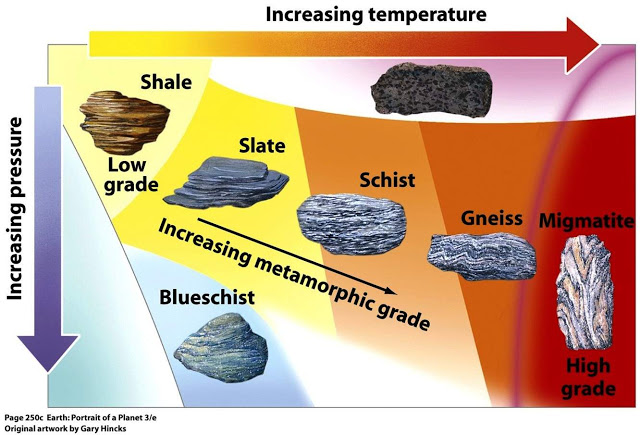
Week 3-5. Introduction of types, grade and facies of metamorphism
Metamorphism.
Types of Metamorphism
1. Contact Metamorphism
2. Regional Metamorphism
3. Cataclastic Metamorphism
4. Hydrothermal Metamorphism
4. Burial Metamorphism
5. Shock Metamorphism (Impact Metamorphism)
1. Contact Metamorphism:
Contact metamorphism occurs adjacent to igneous intrusions and results from high temperatures associated with the igneous intrusion.
Since only a small area surrounding the intrusion is heated by the magma, metamorphism is restricted to the zone surrounding the intrusion, called a metamorphic or contact aureole. Outside of the contact aureole, the rocks are not affected by the intrusive event. The grade of metamorphism increases in all directions toward the intrusion. Because the temperature contrast between the surrounding rock and the intruded magma is larger at shallow levels in the crust where pressure is low, contact metamorphism is often referred to as high temperature, low pressure metamorphism. The rock produced is often a fine-grained rock that shows no foliation, called a hornfels.
2. Regional Metamorphism:
Regional metamorphism occurs over large areas and generally does not show any relationship to igneous bodies. Most regional metamorphism is accompanied by deformation under non-hydrostatic or differential stress conditions. Thus, regional metamorphism usually results in forming metamorphic rocks that are strongly foliated, such as slates, schists, and gniesses. The differential stress usually results from tectonic forces that produce compressional stresses in the rocks, such as when two continental masses collide. Thus, regionally metamorphosed rocks occur in the cores of fold/thrust mountain belts or in eroded mountain ranges. Compressive stresses result in folding of rock and thickening of the crust, which tends to push rocks to deeper levels where they are subjected to higher temperatures and pressures.
3. Cataclastic Metamorphism:
Cataclastic metamorphism occurs as a result of mechanical deformation, like when two bodies of rock slide past one another along a fault zone. Heat is generated by the friction of sliding along such a shear zone, and the rocks tend to be mechanically deformed, being crushed and pulverized, due to the shearing. Cataclastic metamorphism is not very common and is restricted to a narrow zone along which the shearing occurred.
4. Hydrothermal Metamorphism:
Rocks that are altered at high temperatures and moderate pressures by hydrothermal fluids are hydrothermally metamorphosed. This is common in basaltic rocks that generally lack hydrous minerals. The hydrothermal metamorphism results in alteration to such Mg-Fe rich hydrous minerals as talc, chlorite, serpentine, actinolite, tremolite, zeolites, and clay minerals. Rich ore deposits are often formed as a result of hydrothermal metamorphism.
5. Burial Metamorphism:
When sedimentary rocks are buried to depths of several kilometers, temperatures greater than 300oC may develop in the absence of differential stress. New minerals grow, but the rock does not appear to be metamorphosed. The main minerals produced are often the Zeolites. Burial metamorphism overlaps, to some extent, with diagenesis, and grades into regional metamorphism as temperature and pressure increase.
6. Shock/ Impact Metamorphism:
When an extraterrestrial body, such as a meteorite or comet impacts with the Earth or if there is a very large volcanic explosion, ultrahigh pressures can be generated in the impacted rock. These ultrahigh pressures can produce minerals that are only stable at very high pressure, such as the SiO2 polymorphs coesite and stishovite. In addition they can produce textures known as shock lamellae in mineral grains, and such textures as shatter cones in the impacted rock.
Grade of Metamorphism
- Low-grade metamorphism
- High-grade metamorphism
•As the temperature and/or pressure increases on a body of rock we say the rock undergoes prograde metamorphism or that the grade of metamorphism increases. Metamorphic grade is a general term for describing the relative temperature and pressure conditions under which metamorphic rocks form.
•Low-grade metamorphism takes place at temperatures between about 200 to 320oC, and relatively low pressure. Low grade metamorphic rocks are generally characterized by an abundance of hydrous minerals. With increasing grade of metamorphism, the hydrous minerals begin to react with other minerals and/or break down to less hydrous minerals
•High-grade metamorphism takes place at temperatures greater than 320oC and relatively high pressure. As grade of metamorphism increases, hydrous minerals become less hydrous, by losing H2O, and non-hydrous minerals become more common.
Classification of Metamorphic Rocks ((In next lecture will discuss in detail)
Metamorphic rocks are classified on the basis of
- Texture
- Protolith
- Bulk Chemical Composition
certain non-foliated rocks with specific chemical compositions and/or mineral assemblages are given specific names.
Metamorphic Facies (will discuss in detail later on)
- Zeolite facies.
- Prehnite-pumpellyite-facies.
- Greenschist facies.
- Epidote-Amphibolite-facies.
- Amphibolite-facies.
- Granulite facies.
- Ultra-High Temperature Facies.
- Blueschist facies.



